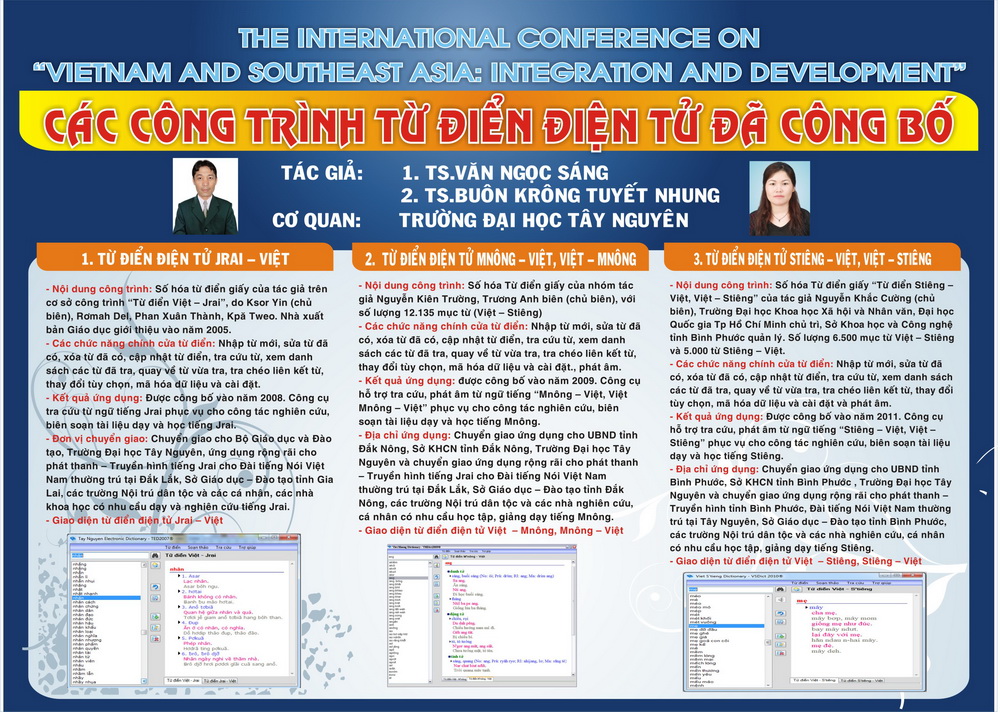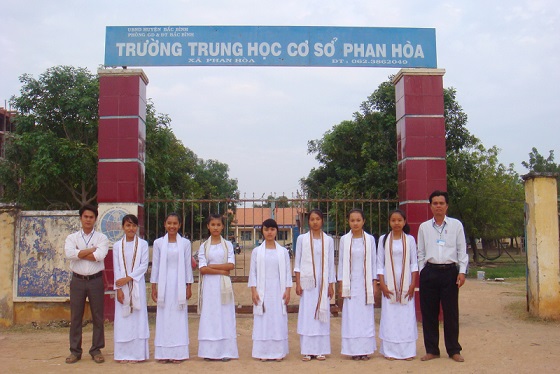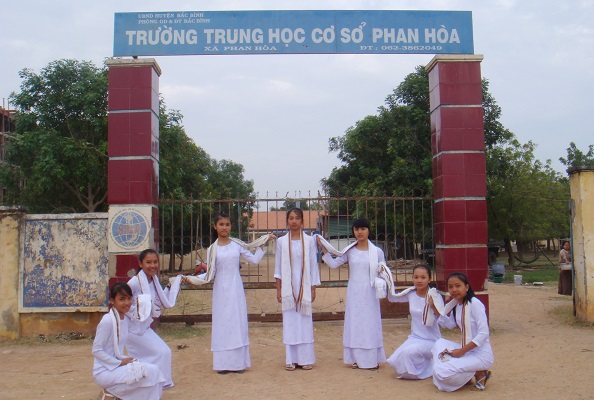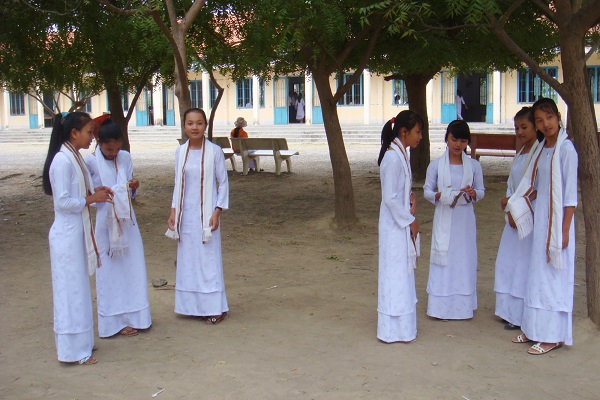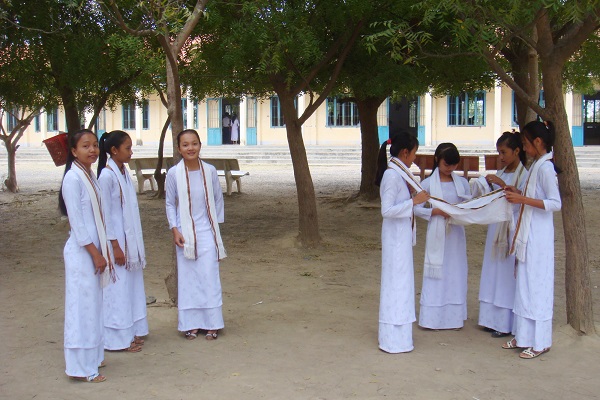Van Ngoc Sang, Mohamad Bin Bilal Ali, Buon Krong Tuyet Nhung. Bảo tồn chữ Chăm qua ứng dụng chuyển tự Cham trực tuyến. [Preserving Cham script through online conversion application]. Hội thảo Quốc tế về Việt Nam và Đông Nam Á: “Hội nhập và phát triển”. [The International Conference on “Vietnam and Southeast Asia: Integration and Development”]. Vietnam, 5- 6, December 2015.
Abstract: This paper aims to introduce some specific results of information technology in Cham language heritage conservation in Vietnam such as creating Cham fonts, and Cham font conversion. In this experiment, for Cham font, the acceptable level of Cham Thrah font is 60% of usability and 65% of high accuracy. On the other hand, the acceptable level for champa font only is (12%, 8%), camtanran is (5%, 14%) and bingu tanran (23%, 13%). For Cham font conversion application, we have checked the accuracy percentage of four Cham poems and results Ariya Gleng Anak 99,88% (n=2459); Nai Mai Mang Makah 100% (n=2523); Ariya Cam Bini 100% (n=1823); Ariya Po Ceng 99,91% (n=2202). Design Cham font and Cham font conversion application are necessaries and meaningful in conservation of Cham script.
Keywords: cham language; cham script; cham font; cham conversion; cham font conversion.
1. Introduction and Background
Cham people are ethnic group of the Champa kingdom was established in the second century in central Vietnam. Cham language is one of the languages in the family of multi-island "Austronesian". Therefore Cham language is closely related with Malay language [3]. As compared to the Malay language, researchers have found traces on stone stele in Java island in the 7th century [1], while Cham letters has also appeared on the first stone stele, namely of Dong Yen Chau (Tra Kieu) in the 4th century [2,6].
Using information technology (IT) to preserve the endangered language is significant in the current, when the digital technology has developed with the diverse features of the storage and dissemination of information. IT has contributed in the indigenous language education, restoring and preserving of ancient script system is a very obvious fact in many countries [4].
Using font to type Cham script on the computer has become essential issues to help compiling textbooks, data storage, teaching and learning Cham script. Cham-Tanran font was created by the EFEO for Macintosh keyboard in 1988 showed that this font has typography and typeface relatively standard. However, this font is still having some defective and technical errors. Cam Thrah.ttf font created by Sang (2002, 2012) and Bingu di tanran.ttf by Cham Unessco (2012) developed from Cham-Tanran (EFEO) rebuilt for Windows keyboard. However these Cham fonts inconsistent the value of the code page, this causes many difficulties in the exchange of information. Besides, these fonts are still limited in the technical thereby create documents not ensure scientific and aesthetic.
Based on the above research on conflict and dangers of the Cham language, as well as the use inconsistent of Cham font typing and storing, we are interested in this issue and the three research questions of this study are as follows:
- What is the choice of Cham script among Cham people?
- How to develop application technology for Cham's script preservation (such as Cham fonts, and convert Cham font)?
- What is the acceptable level of the Cham font conversion application?
2. Research Methodology
Research methodology play an important role in the process of implementing the project, it provides information and steps to carry out the program. In section 1, a brief of historical research on Cham script and Cham fonts are presented and used over time to preserve and conserve the Cham Akhar Thrah.
2.1 Population and Sample
The target population of this study included two groups of people 1) university students, working people; and 2) religious people. An estimated of Cham University students in Binh Thuan Province total about 120 students, and number of Cham working people in Binh Thuan are 195. The scope of the survey for religious group only performed in three villages that are Palei Canat, Palei Dik and Palei Aia Mamih. The numbers of religious people in three villages were 105 people. Hence, the total of population in 2 groups is 420. Meanwhile the totals of items used for Cham script survey are two items: Choosing traditional Cham scrip; and Choosing modified Cham scrip.
According to [5], the ever increasing demand for research has created a need for an efficient method of determining the sample size needed to be presentative of a given population. In order to know the number of sample size to be studied in a total 420 people of population in two groups. To obtain the required sample size using the formula at population is 420, the sample size representative of two groups is 200. The details are shown in Table 1.
Table 1. Proportionate sample techniques of group study
|
Group of study |
Population |
Proportionate sample |
(%) |
|
University students working people |
315 |
150 |
75% |
|
Religious people |
105 |
50 |
25% |
|
Total |
420 |
200 |
100% |
Based on the Table 1 the required sample size for this study has been stated at 200. Out of 200, 75% (150) were come from group1 while 25% (50) were comes from group 2.
2.2 Cham Font Design
In order to design new Cham fonts, we based on a number of valuable documents and dictionary which are using today include Cham-French dictionary of E. Aymonier & A. Cabaton; Cham-Vietnamese-French dictionary of G. Moussay, and Akhar Thrah Cham materials used in Cambodia that is currently stored in the library in French.
Akhar Thrah script is derived from the Sanskrit, difference Latin characters. To design the font for Akhar Thrah, the first step is analysing the number of characters needed to create the font for Akhar Thrah script. The total numbers of Akhar Thrah characters required design are 86 characters. After analyzing and removing some of the same characters as (H), (3), (o), (r), respectively (H) 1, (i) 3, (o) 5, (6) 6, thus, the total number of characters needed to be designed for Akhar Thrah fonts are 82 characters. However, for the convenience of typing Cham script, we design and add seven new punctuation and one characters for using in Latin system, which is , Then, the total numbers of Cham script character need to design are 90 characters as show in Figure 1.
Figure 1. Code point location of Cham Thrah font
2.3 Cham Font Conversion Method
In order to convert EFEO Cham Latin to Cham Akhar Thrah, our approach is to divide the process into two phases. First to convert from EFEO Cham Latin into intermediate characters code and each intermediate character code is corresponding only with a character of Cham Akhar Thrah. In this phase, the process is also selecting the word from Special words list and Special meaning list. This solution can support conversion of many different types of Cham Latin into various Cham fonts. Meanwhile the second phase is converting the intermediate character code corresponding to the Cham Akhar Thrah as shown in the Figure 2.
Figure 2. Diagram of converting EFEO Cham Latin to Cham Akhar Thrah script
3. Experiments
3.1. Exploring the Preferable Cham Script
To explore the preferable Cham script for preservation, a survey to choose which kind of Cham script to use for Cham community. With 200 samples for 2 groups: 1) Religious group and 2) University students and working group [7]. The results show in Figure 3.
Figure 3. Chart of choosing Cham script to use
The chart shows that the number of respondents in all two groups supports using the traditional Cham script is 97,50% whereas only 2,50% supports for using the Modified Cham script. Surprisingly, there is 100% of the Religious group supported the traditional Cham script. During survey, they requested that the Cham people should use the traditional Cham script.
3.2 Creating Cham Font
Fontographer was used to create favorable conditions for design Cham font with a number of important functions such as viewing all the character designs in the window, test or modify the font encoding and kerning in Metrics Window,...and supported on many different operating systems such as Macintosh, Linus, or Windows. This font has been built based on Cham dictionary and design on Unicode. Cham Thrah font typeface is based on drawings presented in Cham - Vietnamese - French dictionary of G. Moussay, published in 1971. The result is shown in Figure 1.
3.3 Converting Cham Font Evaluation
In this experiment the program has been tested with four Cham Poems from EFEO Cham Latin to Cham Akhar Thrah (the traditional Cham script), and Cham script has compared by Cham - French dictionary of E. Aymonier & A. Cabaton; Cham - Vietnamese - French dictionary of G. Moussay and the results is presented in Table 2.
Table 2. Result of Cham font conversion application
|
Number of documents (Cham Poem) |
Number of words |
Checks (%) |
Error (%) |
|
Ariya Gleng anak |
2459 |
99,88 |
0,12 |
|
Nai mai mang Makah |
2523 |
99,92 |
0,08 |
|
Ariya Cam Bini |
1823 |
100 |
0 |
|
Ariya Po Ceng |
2202 |
99,91 |
0,09 |
The following interface is the result of research products and tested the conversion of two first sentence of the poem Ariya Cam Bini as presented in Figure 4.
Figure 4. EFEO Cham Latin to Cham Akhar Thrah interface conversion
4. Results
In the aspect of Cham script conservation, the results are presented in Figure 3. The chart shows that the number of respondents in all two groups supports using the Traditional Cham script is 97,50% whereas only 2,50% supports for using the Modified Cham script. Besides, there is 100% concern the Religious group supported the Traditional Cham script.
Cham Thrah fonts have significant in using, typing document, research, communication and teaching Cham language. Compared with camtanran.ttf, champa.ttf, bingudi tanran.ttf, it is so that cham Thrah fonts have outperformed with high accuracy and easy to use. Moreover, on both Windows and Macintosh keyboard, the cham thrah font has the same codepoint value, and then it is very convenient for users. In survey 50 users, result shows that cham thrah font has surpassed in accuracy and ease of use as shown in Figure 5. Specifically, the acceptable level is 60% of usability and 65% of high accuracy. On the other hand, the acceptable level for champa font only is (12%, 8%), camtanran is (5%, 14%) and bingu tanran (23%, 13%).
Figure 5. Chart of survey and assessment Cham font
Cham font conversion applications with the interface are shown in the Figure 4. The accuracy percentage of four Cham Poems is presented in Table 2. Poem Ariya Gleng anak (99,88%); Nai mai mang Makah (99,92%); Ariya Cam Bini (100%); Ariya Po Ceng (99,91%). Cham font conversion application will be used in schools, institutions as well as in assisting teaching and learning Cham language.
5. Conclusions
This study has been conducted to identify the choice of Cham script among Cham people about traditional Cham script and modified Cham script, and also carry out a new approach in analysing and designing all code point value of Cham fonts reasonable on the keyboard. Cham fonts have been design based on Unicode and using for both Macintosh and Windows keyboard. Hence, Cham Thrah character and Times New Roman characters have the same size in the same text. Therefore the conversion or storage information on both operating systems is stable results. In addition, the applications of Cham font conversion from EFEO Cham Latin to Cham Akhar Thrah from the experiments were highly accurate. Information technology applications to create Cham font and converting Cham font have an important implication in Cham language conservation.
References
- Casparis, J. G. d. (1956), "Prasasti Indonesia II: Selected Inscriptions from the 7th to the 9th Century A.D", Bandung: A.C. Nix & Co.
- Coedes, G. (1939), "La plus ancienne inscription en langue chame". Eastern and Indian Studies in Honour of F.W. Thomas. New Indian Antiquary Extra Series I. Po Dharma, " History of language and Cham script",Conference Proceedings on 21-22 September, 2006. Kuala Lumpur, EFEO & Tokyo University of Foreign Studies, Kuala Lumpur, 2007 (CD-Rom). p. 46-49.
- Dharma Po. (2006), "Ngon ngu chu viet Cham trong qua trinh lich su (Cham language and script in historical process)". Paper presented at the Conference Proceedings of the 2006 History of language and Cham script. 21-22 September. Kuala Lumpur, EFEO & Tokyo University of Foreign Studies, Kuala Lumpur, 2007 (CD-Rom).
- Grenoble, L. A., & Whaley, L. J. (2006), "Saving languages: An introduction to language revitalization". Cambridge, UK: Cambridge University Press.
- Krejcie, R. V., & Morgan, D. W. (1970), "Determining Sample Size for Research Activities". Educational and Psychological Measurement, (30) 607-610.
- Lafont, P. B. (2011), "Vuong Quoc Champa: Dia Du, Dan Cu va Lich Su (Kingdom of Champa: Geography, Population and History) (Vol. Champaka No. 11). San Jose, USA: International Office of Champa.
- Văn Ngọc Sáng, Mohamad Bin Bill Ali, Hamdan Said (2013), "Information Technology and Indigenous language preservation, A case study in the Malayyu Cham language in Viet Nam", International conference “The 10-Year Implementation of the UNESCO Convention for the Safeguarding of Intangible Cultural Heritage: Experiences, Lessons and Future Directions” in Hoi An City, Quang Nam Province.
Poster Presentation

